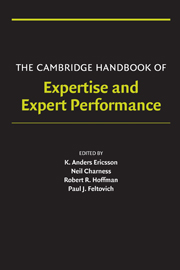Book contents
- Frontmatter
- Contents
- Acknowledgments
- Contributors
- PART I INTRODUCTION AND PERSPECTIVE
- PART II OVERVIEW OF APPROACHES TO THE STUDY OF EXPERTISE – BRIEF HISTORICAL ACCOUNTS OF THEORIES AND METHODS
- 4 Studies of Expertise from Psychological Perspectives
- 5 Educators and Expertise: A Brief History of Theories and Models
- 6 Expert Systems: A Perspective from Computer Science
- 7 Professionalization, Scientific Expertise, and Elitism: A Sociological Perspective
- PART III METHODS FOR STUDYING THE STRUCTURE OF EXPERTISE
- PART IV METHODS FOR STUDYING THE ACQUISITION AND MAINTENANCE OF EXPERTISE
- PART V DOMAINS OF EXPERTISE
- PART VI GENERALIZABLE MECHANISMS MEDIATING EXPERTISE AND GENERAL ISSUES
- Author Index
- Subject Index
- References
6 - Expert Systems: A Perspective from Computer Science
from PART II - OVERVIEW OF APPROACHES TO THE STUDY OF EXPERTISE – BRIEF HISTORICAL ACCOUNTS OF THEORIES AND METHODS
- Frontmatter
- Contents
- Acknowledgments
- Contributors
- PART I INTRODUCTION AND PERSPECTIVE
- PART II OVERVIEW OF APPROACHES TO THE STUDY OF EXPERTISE – BRIEF HISTORICAL ACCOUNTS OF THEORIES AND METHODS
- 4 Studies of Expertise from Psychological Perspectives
- 5 Educators and Expertise: A Brief History of Theories and Models
- 6 Expert Systems: A Perspective from Computer Science
- 7 Professionalization, Scientific Expertise, and Elitism: A Sociological Perspective
- PART III METHODS FOR STUDYING THE STRUCTURE OF EXPERTISE
- PART IV METHODS FOR STUDYING THE ACQUISITION AND MAINTENANCE OF EXPERTISE
- PART V DOMAINS OF EXPERTISE
- PART VI GENERALIZABLE MECHANISMS MEDIATING EXPERTISE AND GENERAL ISSUES
- Author Index
- Subject Index
- References
Summary
Expert systems are computer programs that exhibit some of the characteristics of expertise in human problem solving, most notably high levels of performance. Several issues are described that are relevant for the study of expertise and that have arisen in the development of the technology. Moreover, because expert systems represent testable models that can be manipulated in laboratory situations, they become a new methodology for experimental research on expertise. The main result from work on expert systems has been demonstrating the power of specialized knowledge for achieving high performance, in contrast with the relatively weak contribution of general problem solving methods.
AI and Expert Systems: Foundational Ideas
A science evolves through language and tools that express its concepts, mechanisms, and issues. The science of studying expertise evolved largely in the second half of the 20th century. It is not accidental that this coincides with the development of the digital stored-program computer, computer programming, artificial intelligence (AI) research, and information-processing models of human cognition (Feltovich, Prietula, & Ericsson, Chapter 4). The language of cognitive information processing was developed by the same AI researchers and cognitive psychologists that had adopted computation as the basis for models of thought (Anderson, 1982; Feigenbaum & Feldman, 1963; Newell & Simon, 1972; VanLehn, 1996).
AI's scientific goal is to understand intelligence by building computer programs that exhibit intelligent behavior and can be viewed as models of thought.
- Type
- Chapter
- Information
- The Cambridge Handbook of Expertise and Expert Performance , pp. 87 - 104Publisher: Cambridge University PressPrint publication year: 2006
References
- 5
- Cited by



